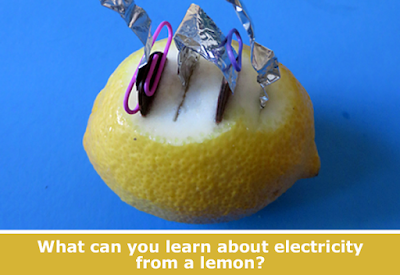Explore electricity with a homemade battery in this week's science activity spotlight.
Lemon Battery
Hands-on science activity
Ever wondered how a battery works to store and generate electricity? With a lemon, a penny, some plastic coated paper clips, and aluminum foil, you can make a fruit-powered battery and really see how the process works! What kinds of materials conduct electricity? What about a lemon makes it capable of producing electricity? The power from a lemon isn't going to be enough to power your cell phone, but in this week's hands-on family science activity, kids can experiment with a homemade, low-voltage battery using a lemon and "feel" the electricity created. Using other projects (see below), families and students can expand the science exploration to other fruits and vegetables and more in-depth investigation.
Lemons may be sour, but in this science activity, getting a charge from a lemon is about electricity, not taste!
Generate Electricity with a Lemon Battery (Science Buddies activity)
Generate Electricity with a Lemon Battery (science activity at Scientific American)
Potato Batteries: How to Turn Produce into Veggie Power! (related Science Buddies project idea)
A Battery That Makes Cents (related Science Buddies project idea)
Not Just for Lemons!
Lemons are a great way to experiment with a produce-powered battery, but they are not the only fruit or vegetable you can hook up to generate electricity. With the Veggie Power science kit (and Potato Batteries Science Buddies Project Idea), students can experiment with similar concepts using copper and zinc electrodes. What fruits and vegetables work best? How much power can you generate this way?
Ads
Subscribe to:
Post Comments (Atom)
-
Introduction :- The term digital marketing was first used in the 1990s,but digital marketing has roots in the mid-1980s, when the SoftAd ...
-
https://www.kalerkantho.com/online/lifestyle/2020/11/14/975592স্ট্রোক এমন একটি রোগ, যা মস্তিষ্কের অভ্যন্তরে এবং এর ভেতরের ধমনিগুলোকে প্রভাবি...
-
Inductive Sensor There are four types of sensors: inductive, capacitive, ultrasonic, and photoelectric. nductive sensors :...
-
I know, as a blogger, you care your blog design, template or theme you use on your blog. It's reflecting your personality in a way, don...

No comments:
Post a Comment